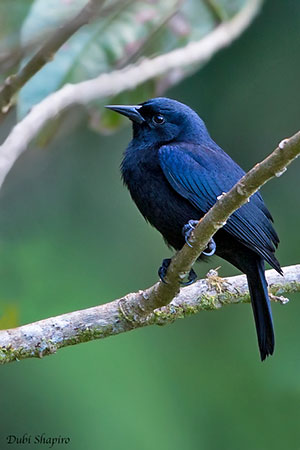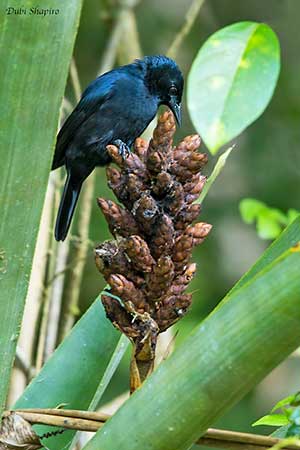
Fr: Carouge de Jamaïque
Ang: Jamaican Blackbird
All: Bromelienstärling
Esp: Zanate Jamaicano
Ita: Ittero della Giamaica
Nd: Jamaicaanse Troepiaal
Sd: bromeliatrupial
Photographer:
Dubi Shapiro
Dubi Shapiro Photo Galleries & Dubi Shapiro's Pictures on IBC
Text by Nicole Bouglouan
Sources:
HANDBOOK OF THE BIRDS OF THE WORLD Vol 16 by Josep del Hoyo- Andrew Elliot-David Christie – Lynx Edicions – ISBN: 9788496553781
BIRDS OF THE WEST INDIES – by Herbert Raffaele, Kristin Williams et Tracy Pedersen – Helm – ISBN: 9780713649055
Animal Diversity Web (University of Michigan Museum of Zoology)
Neotropical Birds – Cornell Lab of Ornithology
Wikipedia, the free encyclopaedia
Jamaican Blackbird
Nesopsar nigerrimus
Passeriformes Order – Icteridae Family
INTRODUCTION:
The Jamaican Blackbird is endemic to Jamaica where it frequents wet forests in mountains, and humid woodlands at mid-elevations outside breeding season.
It feeds mainly on various insects species and other invertebrates caught in epiphytic bromeliads in trees. This monogamous species is territorial and breeds solitary. Both adults share most of nesting duties.
The Jamaican Blackbird is threatened by habitat loss through plantations of Pinus caribaea and coffee, farming and human developments. The species is currently classified as Endangered.
DESCRIPTION OF THE BIRD:
Biometrics:
Length: 18 cm
Weight: 38-39 g
The Jamaican Blackbird is a medium-sized bird. It has black plumage overall, with blue gloss.
The black bill is pointed. This species has strong jaws adapted to hammering and probing behaviour. The eyes are dark brown. The short legs and feet are black, with fairly long claws.
Male and female are similar.
The juvenile has heavily tinged brown plumage, without gloss and duller than adults.

RANGE:
The Jamaican Blackbird is endemic to Jamaica. It has isolated populations in Cockpit Country, the Blue and John Crow Mountains and the central hills.
HABITAT:
The Jamaican Blackbird frequents wet forests with trees covered with epiphytes and mosses, and especially bromeliads. It is rare or absent in drier forest on windy slopes and ridges. It is occasionally found in humid woodlands at lower elevations. The species is usually visible up to 2,200 metres, but during the non-breeding period, it occurs mainly around 200 metres of elevation.
CALLS ANS SONGS: SOUNDS BY XENO-CANTO
The Jamaican Blackbird utters a loud, wheezy song “zwheezoo-whezoo whe” delivered by both male and female. The common call is a sharp “chek”.
BEHAVIOUR IN THE WILD:
The Jamaican Blackbird feeds primarily on insects such as coleopteran, orthopteran and lepidopteran caterpillars. It also consumes spiders, snails, tree-frogs and small lizards (Anolis). It also feeds on berries.
It forages in moss and epiphytic bromeliads covering tree trunks, between 3 and 12 metres above the ground.
It can be seen climbing up vertical trunks and larger branches, thanks to the long, strong claws. The short tail is used in woodpecker-like action to keep the balance against the trunk. It searches for prey in bromeliads and moss by inserting the pointed bill into the plants, sometimes tearing plant material and pecking into rotten wood. It is primarily arboreal.

The Jamaican Blackbird is usually found in pairs and family groups. These birds are monogamous and territorial. Both mates spend most of the time together, but when separated, they perform aerial displays above the tree canopy while singing, and echo one another’s calls.
The “butterfly-flight” display shows the bird descending slowly with low wingbeats, and then, it closes its wings and dives back into the canopy.
The Jamaican Blackbird is resident and only performs some altitudinal movements down to 200 metres of elevation outside the breeding season.
The flight is strong with slow wingbeats.
REPRODUCTION OF THIS SPECIES:
The breeding season takes place between May and July.
The Jamaican Blackbird is territorial and breeds in isolated pairs. Several pairs may have large territories, but they do not overlap.
The female builds a bulky, cup-shaped nest with epiphytic plants and rootlets. It is placed in tree, between 6 and 11 metres above the ground, often beneath an epiphytic bromeliad.
The female lays two white eggs with sparse darker markings. She incubates alone during 13-15 days, while the male protects her and defends the nest-site against intruders, attacking them vigorously when they approach too close.
Both parents feed the young with insects. They remain in family group for at least two months after fledging.
PROTECTION / THREATS / STATUS:
The Jamaican Blackbird has restricted range. It is threatened by habitat loss through forest clearance for plantations of Caribbean Pine and coffee, farming, human developments, removal of trees for charcoal-burning and fires.
The Shiny Cowbird parasitism is increasing while the habitat is degraded.
The population is roughly estimated to number 1,500/7,000 mature individuals and is suspected to be decreasing slowly.
The Jamaican Blackbird is currently listed as Endangered.